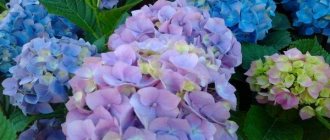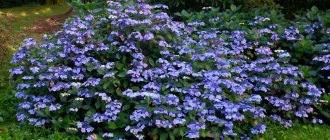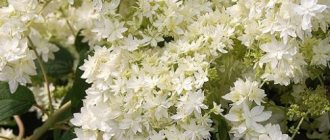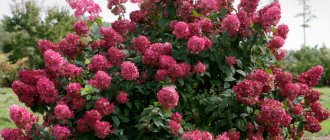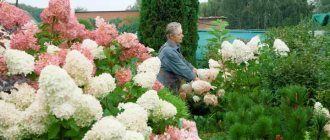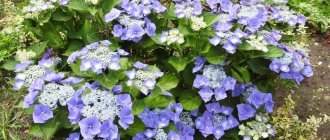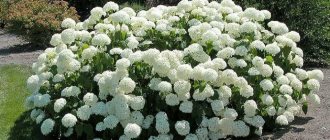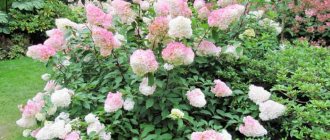Description and characteristics of the variety
Hydrangea (hydrangea) Eternal summer is a perennial frost-resistant beautiful flowering plant that grows no more than 1 meter in height. On erect shoots there are oval leaves of a rich green hue. The ends of the leaf plates are slightly pointed and elongated, and the edges are jagged.
The Eternal Summer variety has lush inflorescences of lilac, blue or pink flowers
Large spherical inflorescences are located at the top of the shoots. The small flowers have a single row of blue, lilac and pink petals. Hydrangea blooms all summer, and new buds bloom to replace the fading buds. Endless summer is a large-leaved hydrangea.
Important! In addition to Endless Summer, the group includes other beautifully flowering varieties: Everlasting Magical Opal, Pink Annabelle, Bloomstar, Twist and Shout. All of their seedlings can be purchased in special nurseries.
Application in landscape design
Large-leaved hydrangea of the Endless Summer variety, due to its strong growth rate, is actively used in landscape design. It is often planted as a decorative background for lower shrubs. The leaf plate of a rich green hue can beautifully set off the light flowers that grow nearby. If you do not want to create an eternal green corridor along the garden, then you do not need to plant plants along the paths.
The advantage of hydrangea is that its flowers dry quickly in the open air, so they can stand for a long time and not lose their beauty. Some summer residents grow this variety with endless flowering in containers. Thanks to this, you can decorate your veranda or yard.
Did you know? After excavations in North America, scientists concluded that hydrangea grew more than 40 thousand years ago.
How and where to plant
Hydrangea Annabelle - planting and caring for the plant in open ground
To grow hydrangeas, you need to choose sunlit areas. However, it is worth considering that the open area should not be blown through by cold winds. Locations near buildings, hedges or tall trees are best.
Planting Hydrangea Summer is carried out as follows:
- All weeds are removed from the dug area with a rake.
- Organic fertilizers are applied: humus, rotted manure, compost.
- Dig holes 3 centimeters deeper than the length of the roots.
- The bottom of each hole is covered with drainage material with a layer of 4-6 centimeters.
- The soil mixture is poured on top of it.
- The wells are moistened with slightly warm water.
- Plant one seedling per hole.
- Sprinkle around with the remaining soil mixture.
After planting, it is necessary to strictly monitor the condition of the seedlings for about half a month. It is recommended to regularly water the soil and mulch the soil with dry leaves or sawdust.
Some practical tips
First, let us once again draw your attention to the fact that when choosing this or that variety, first of all look at how adapted it is to our climatic conditions and resistant to diseases. You may find it useful to know some of the features of growing large-leaved hydrangea in the garden:
- it is advisable to plant plants in loose soil, so that it will wake up faster in the spring;
- plant the plant on an elevated area, since it overwinters better with low humidity;
- before covering the bush for the winter, be sure to saturate the hydrangea’s earthen ball with water and feed it with potassium and phosphorus fertilizers;
- do not rush to remove the shelter in the spring, as this shrub is difficult to tolerate returning spring frosts, more difficult than winter frosts;
- After the spring cold has passed, do not immediately remove the spunbond or lutrasil covering the hydrangea, because the bright sun can burn the tender shoots.
Shrub care
Hydrangea Polar Bear - description and care of the plant
After planting and caring for the Eternal Summer hydrangea, special attention must be paid. Mistakes made in growing flowering plants immediately affect their ability to bloom buds.
The bush needs to be watered abundantly
Watering
The moisture-loving Endless Summer hydrangea is especially sensitive to soil moisture. The soil should not be allowed to dry out, so it is recommended to mulch the surface of the earth.
Important! You need to water the soil with high-quality water, the temperature of which should be from 18 to 25 degrees.
Top dressing
Hydrangea largeleaf Endless summer needs to be fed twice a month. During the growth of leaf mass, the flower needs nitrogen fertilizers, and with the beginning of flowering - potassium-phosphorus fertilizers.
Trimming
Pruning is a mandatory procedure for caring for hydrangea. It is carried out in the fall, rotten and dry shoots are removed at the root. If the bush is more than 4-5 years old, then you need to cut off the old branches so that the bush is renewed.
Landing
Large-leaved hydrangea variety Endless Summer has several advantages over other varieties:
- frost resistance: plants can survive cold spells down to -30°C;
- flowering observed in spring and summer, so this period is 3 months longer than other varieties.
Planting hydrangeas must be done in the right place and under certain conditions. If you carry out the procedure, adhering to all the recommendations, then by next year you will be able to enjoy beautiful flowering bushes.
Selecting a location
It is very important to choose the right place for planting. If you plant planting material in the northern part of the site, then you need to do it in open areas. Plants must receive sufficient solar heat and lighting.
Planting on the south side of the garden requires protecting the bushes from direct sunlight. The soil for planting should be nutritious, but with an average level of acid and alkali (from 5 to 7.5). The distance between the bushes should be such that they do not touch each other.
Soil preparation
The soil should be moistened, but not too much, so a month before the proposed planting (it can be done in spring and autumn), you need to dig up the area and apply fertilizer (humus or peat). 4 buckets of nutrients are scattered per 1 m². After this, water the soil with water at the rate of 50 liters per 1 m².
You need to mark the area a week before planting. Holes measuring 50x50 cm are dug at a distance of 2 m from each other. If groundwater comes closer than 2 m to the ground, then a drainage system must be installed. For this, expanded clay or crushed stone is used. The drainage layer should be about 20 cm.
Planting process
The planting technology is as follows:
- Sprinkle the drainage layer with nutritious soil. To do this, mix garden soil with peat (in a ratio of 2:1) and add 100 g of superphosphate.
- Place the seedling inside the hole and distribute the roots.
- Dig a metal rod nearby, 30 cm long above the seedling. Tie a plant to it.
- Cover the hole with soil and pour in 30 liters of water.
- Compact the soil to prevent voids from forming in the root system.
- Mulch with a 20-centimeter layer of humus or peat.
When growing hydrangea of the Endless Summer variety, it is necessary to properly care for it. It will be necessary to apply fertilizers in a timely manner, water the bushes and prepare them for winter. Do not forget also about loosening the soil and removing weeds along with the roots. Such simple actions will not only improve the appearance of the plant, but also protect it from diseases and pests.
Watering
Shrubs should be watered sparingly. If the soil is excessively moist, the number of flower ovaries on the plants will decrease.
The required amount of water must be determined based on the type of soil:
- pour no more than 20 liters of water per 1 m² into clayey soils;
- in sandy areas - at least 30 liters of water per 1 m²;
- in loamy soils - about 25 liters per 1 m², given that it retains moisture well.
If you have planted a large number of hydrangeas, it is best to irrigate the area using a hose with many holes in it. You can also install drip irrigation to evenly distribute moisture.
Feeding and fertilizers
Fertilizing is applied in late spring and early summer. to stimulate flower activity . 70 g of this substance is added to each bush. To provoke abundant flowering, you need to add potassium nitrate . Apply 50 g of fertilizer per plant.
Trimming
Only those bushes that are more than 3 years old are pruned. In autumn, old and damaged shoots are removed, thereby activating the growth of young branches. There is no need to prune faded flowers, as they protect the plants from freezing. They need to be removed in the spring so that new buds form.
Insulation for the winter
Despite the fact that the Endless Summer hydrangea is a winter-hardy crop, the plants need to be covered for the winter . If this is not done, it will be difficult for the shrubs to recover after the cold season.
Propagation of hydrangea Endless Summer
Any cultivation of ornamental plants is not complete without their reproduction. Hydrangeas are mainly propagated only using cuttings. The bush whose shoots are pruned must be older than 3 years.
Hydrangea Hot Red - variety description, planting and care
Description of the flower propagation procedure step by step:
- The lower leaf plates are removed from the cuttings, but at least 3 leaves are left on top.
- Then the box is filled with substrate and the cut shoots are planted along its edge.
- The top of the container is covered with film for a greenhouse effect.
- Water the cuttings twice a week until they take root.
Note! Large-leaved varieties of hydrangea are practically not propagated by seeds; this method is used only by breeders.
History of creation
According to official information, Endless Summer appeared in 2003 in the USA, in the state of Minnesota. However, in reality, work on its breeding began much earlier, back in the 20th century. The winter of 1982 in the mentioned region turned out to be incredibly cold. Most of the cultivated plants in the local nursery froze under the influence of arctic air. But in the garden next door, hydrangea bloomed in the spring. Breeders paid attention to this phenomenon, and three years after the incident, a cutting from the mentioned crop was planted in the nursery. Later it turned into a vigorous, powerful shrub, resistant to serious temperature fluctuations. For 21 years, scientists have been working to improve this plant. They do not stop to this day, since the main task of breeders remains to make Endless Summer even more frost-resistant and to achieve the appearance of flowers with wavy edges on it. By the way, the name of the crop is due to the ability of the plant to bloom repeatedly.
The variety is registered as Endless Summer Hydrangea and Hydrangea macrophylla Bailmer PPAF (plant patent applied for). It is believed that it may be a mutation of the Nikko Blue variety.
Pests and diseases
Hydrangea Endless Summer is one of the few flower varieties that is immune to a disease called powdery mildew. But a false version of this disease often affects ornamental bushes. A whitish coating forms on the leaf blades, which inhibits the normal development of the plant. To combat this, drugs containing copper are used.
For your information! A well-known folk remedy for downy mildew is treatment with copper sulfate.
Bush diseases
Chlorosis is another disease that can affect the bush. The leaf blades begin to fade as the process of chlorophyll formation in the cells is disrupted.
The causes of this disease may be:
- lack of natural light, so necessary for photosynthesis and the formation of chlorophyll;
- low-quality irrigation water: hard tap water, with a high alkali content;
- elevated temperatures, prolonged dry periods.
To get rid of chlorosis, the plant is sprayed with a solution of iron sulfate, and the soil is also treated with it.
Spider mites are among the pests of Endless Summer. These are small insects that are located on the underside of leaves and weave a thin web. Parasites eat the succulent parts of leaves and stems, which causes the bush to stop developing and flowering.
Note! To control pests, special chemicals are usually used - insecticides, but spider mites must be destroyed with acaricides.
The flower pleases its owners by blooming until the end of summer
Hydrangea Eternal Summer is a variety that blooms with double blue, pink and purple inflorescences. This is a unique flower, which, despite its external fragility, is highly resistant to cold and disease. If you take care of it regularly and in a timely manner, it will not cause any trouble and will delight you with its beautiful flowering until the end of summer.
XXI CENTURY Candy Fudge Scented water
266 ₽ More details
Video baby monitor Motorola MBP36S (white)
12900 ₽ More details
Fashionable jeans 2020-2021 for women
To cover or not?
Most gardeners, having read that in our conditions large-leaved hydrangea (frost-resistant varieties) do not need shelter for the winter, started a serious discussion both on the Internet and on the pages of magazines. But practice, as is usually the case, put everything in its place. If a gardener wants to enjoy flowering from the beginning of summer until frost, then, of course, it is worth covering. If you are pleased with the not very long and abundant flowering from mid-summer to autumn, then you don’t have to cover it. Many who have bought large-leaved hydrangea seedlings are perplexed: “How is it that it is written that it overwinters without shelter, but experts say the opposite?” The fact is that last year’s buds, not protected from negative winter temperatures, will die, but new shoots must still grow before forming inflorescences and blooming. Therefore, before purchasing this truly beautiful plant, think about whether you can create the most favorable conditions for it.
